Travelers’ ideal destination is Spain. The splendor of a caliph’s castle, days in the heat on Mediterranean beaches, and the mark of heels from a flamenco dancer. These kinds of travel experiences encapsulate the essence of Spain, showcasing the nation’s captivating natural beauty, fascinating history, and rich culture.
Spain emits a lively energy and a mesmerizing blend of past and present, from the busy street life of Plaza Mayor in Madrid and La Rambla in Barcelona to the forest of columns and Moorish arches receding into the silent vastness of Cordoba’s Great Mosque. You’ll be pleasantly pleased by what you discover if you travel off the usual tourist routes and explore less tourist-oriented places.
Table of Contents
Spain Tourist Attraction
The Alhambra and Generalife Gardens, Granada
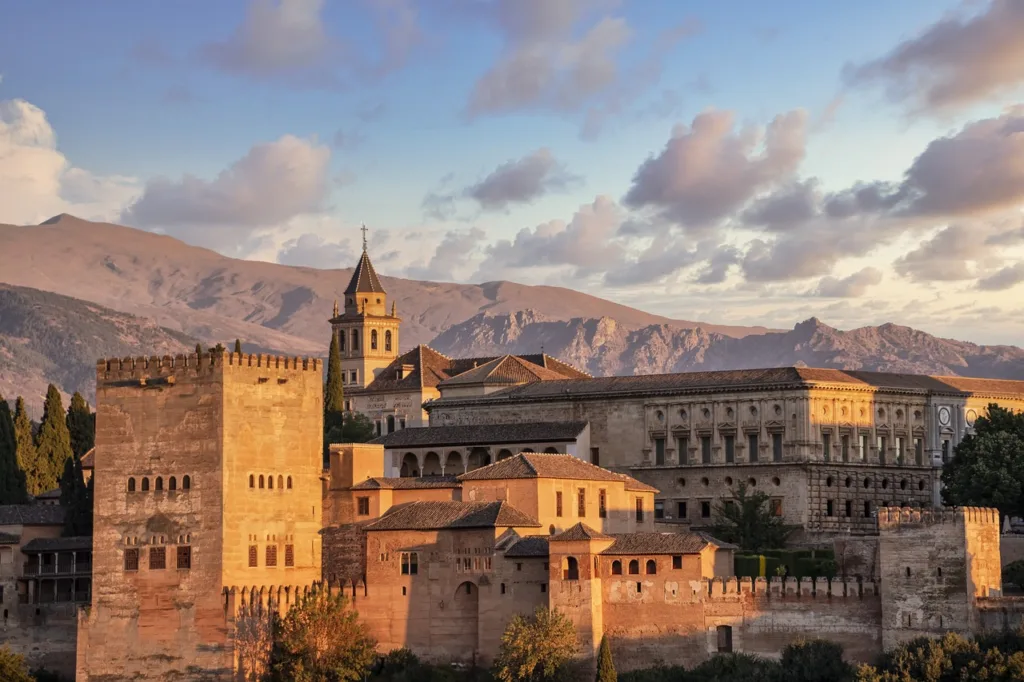
Regardless of how much you’ve read or seen images of Granada’s Alhambra palaces, you will still be in awe of this Moorish pleasure palace. The artistic pinnacle of Islamic Spain is the royal palace of the Nasrid dynasty, when Al-Andalus, or Andalucía, was considered the height of European civilization throughout the Middle Ages.
The Alhambra complex consists of a number of buildings, towers, walls, gardens, and a mosque, but what will haunt your nightmares are the exquisitely detailed stone carvings, the delicate filigrees, the spectacular ceilings covered in tiles, the graceful arches, and the calm courtyards of the Nasrid palace.
Nevertheless, even in its incomplete form, the neighboring palace constructed for Emperor Charles V stands as Spain’s best example of High Renaissance design. Additionally, the tiered gardens of Generalife provide a tranquil break from the opulence as well as breathtaking views of the remaining Alhambra.
Note : The Alhambra is big, takes a lot of walking, and is a sight to behold. Do not anticipate a brief visit. Make sure to reserve your tickets much in advance. During peak seasons, tickets for this popular tourist destination in Spain sell out weeks in advance.
It takes at least half a day to visit the Alhambra palaces, and several days are needed to fully explore all of Granada’s tourist sites. Other notable attractions in Granada, besides the Alhambra, are the medieval Moorish Albaicín area, which is recognized by UNESCO, the 16th-century Capilla Real de Granada (Royal Chapel), and the Sacromonte quarter, which is home to flamenco concerts held in gypsies. caves.
Barcelona’s Sagrada Familia and Gaudí Sites
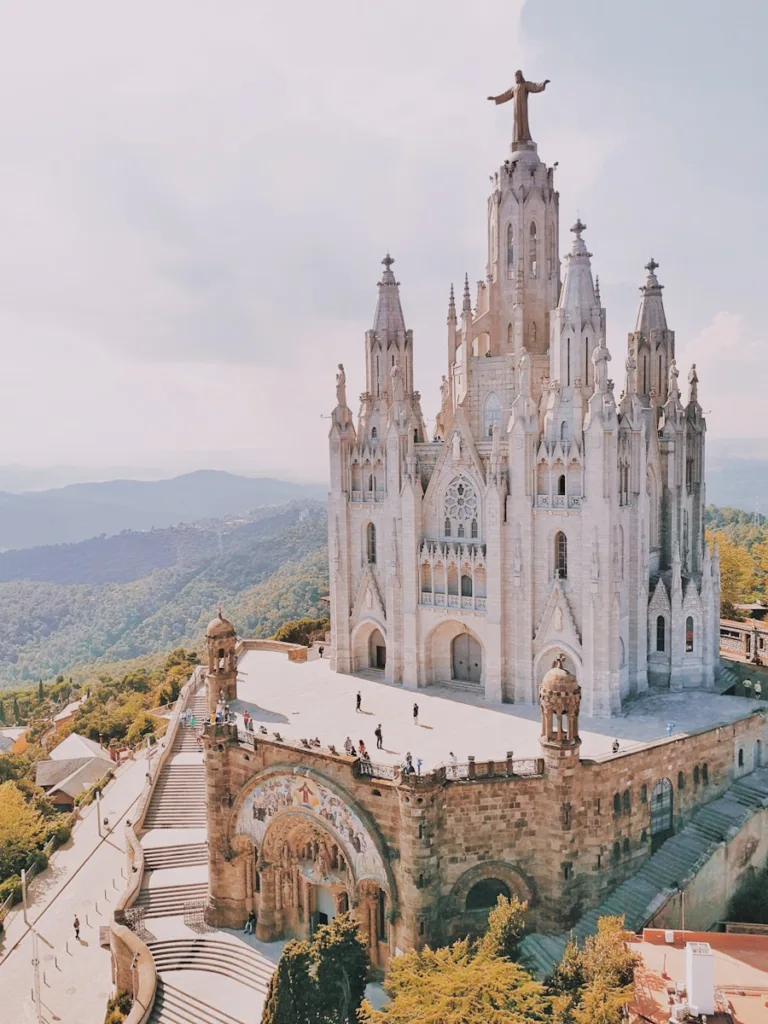
Some have said that Antoni Gaudí even went as far as to bring the Art Nouveau architectural style to an absurdity. His bizarre and fantastical structures in Barcelona have grown to become iconic sites for tourists visiting this Catalan metropolis.
The first is the Basilica de la Sagrada Família, also known as the Holy Family Church of the Atonement or the Temple Expiatori de la Sagrada Família. Not only is it one of the most unusual churches in all of Europe, but you can see the ongoing construction as you look down from the tower.
In Gaudí’s final and most well-known secular work, Casa Milà, you may look for absolute straight lines, but you will find it more akin to a work of sculpture than a useful structure.
Make sure you climb up to the roof, as it is thought that the chimneys served as the inspiration for Darth Vader’s appearance in Star Wars.
On its rooftop terrace, the magnificent Casa Batlló, a famous Gaudí structure featuring mask-shaped balconies and a flowing façade, hosts Magic Nights outdoor performances.
From a hilltop location, Parc Güell commands a stunning perspective of the city. The gardens and vistas are framed by fanciful fish, salamanders, and octopuses, as well as vibrant ceramic-chard mosaics. Near the entryway, a whimsical towering house is primarily covered in vibrant ceramic pieces.
For purely aesthetic reasons, Gaudí’s monuments are appealing to both adults and youngsters who have no interest in architecture.
The Great Mosque of Córdoba (La Mezquita)

The Great Mosque of Córdoba, Spain’s best example of Moorish architecture, is one of the largest mosques in the world and was once the main mosque of western Islam. It is still known by its original name, La Mezquita.
Despite subsequent modifications that removed part of its structure to accommodate a Catholic cathedral, the Great Mosque and the Alhambra in Granada are two of the best representations of Islamic art and architecture in western Europe.
The construction, which started in 785, employed materials from Visigothic and Roman buildings. By 1000, it had developed to its current size, with a prayer hall that has no fewer than nineteen aisles.
Its rows of columns and graceful Moorish arches line up in regular patterns no matter where you stand or look.
La Mezquita is located in Cordoba’s downtown, adjacent to a number of the city’s main attractions. Take a leisurely stroll to the Puente Romano, also known as the Puerta del Puente, or locate a dining establishment along the riverbank.
The flower-decked patios in Judería, the old Jewish quarter near the Great Mosque, the 15th-century aristocratic palace Palacio de Viana, and the 13th-century Alcázar de los Reyes Cristianos, the former Caliphal Palace that was taken over by Catholic king Fernando III, are a few more highlights. The Judería is filled with low, whitewashed dwellings, narrow, winding lanes, and small squares that give the area a Moorish feel that has been carried over from its past.
Seville Cathedral and Alcázar
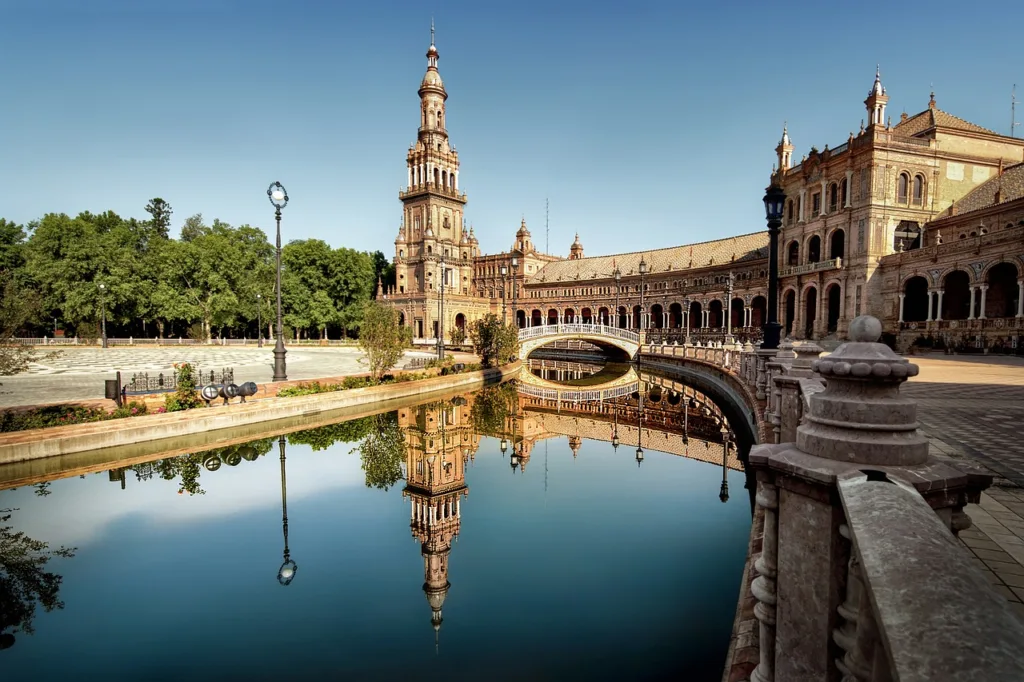
There’s no avoiding the Seville Cathedral. Dominating the city center, this massive edifice is the largest Gothic cathedral in the world.
A UNESCO World Heritage Site is made up of the Alcázar, the Catedral de Sevilla, and the La Giralda tower. The top three tourist destinations in Seville are these three outstanding historic sites.
Although the cathedral is impressive from the outside, you can truly grasp its enormity by entering and moving alongside the enormous columns. St. Peter’s in Rome is smaller than the Cathedral of Seville. The carved figures on the main altar, which stands 37 meters tall, are entirely coated in gold. Four enormous figures are holding the colossal grave of Christopher Columbus above.
La Giralda, a marvel of Almohad architecture, was once a minaret and is all that remains of the Great Mosque in the city, which was demolished to make way for the cathedral.
The Moors started construction on the Alcázar, which stands in front of the cathedral, in 712, and Pedro I altered it in the elaborate Mudéjar style—a combination of Gothic and Muslim architectural elements—after the Christian Reconquista. With whimsical details like intricately tiled walls and patterned ceilings, the rooms and salons are beautiful.
The lovely Alcázar grounds, shaded by aromatic orange and lemon trees, were depicted in the television series Game of Thrones. Viewers of this program might be familiar with the fountains from the Water Gardens of the Kingdom of Dorne.
The Barrio de Santa Cruz, once known as the Judería (Jewish quarter), borders the Alcázar to the east. It is a neighborhood with whitewashed residences, iron balconies, and flower-filled courtyards.
The Prado and Paseo del Artes, Madrid

The Prado, one of the most popular tourist destinations in Madrid, is so rich in its collection that it is ranked among the best art museums in the world. But when you combine the Thyssen-Bornemisza National Museum, the CaixaForum, and the Reina Sofía National Art Museum with Madrid’s mile-long promenade shaded by trees, you get what could be the greatest concentration of precious art treasures in the world. It makes sense that this is referred to as the Boulevard of the Arts, El Paseo del Arte.
With the largest collection of Spanish art in the world, the Prado features pieces from Spain’s golden age, including those by El Greco, Velázquez, and Goya. The collection spans an incredible period, from medieval masterpieces from the 12th century to the avant-garde movement of the early 20th century.
The artwork on display includes paintings by Flemish and Dutch artists (don’t miss the fantasy world of Hieronymus Bosch and pieces by Rubens and Brueghel), Italian art (Botticelli, Raphael, Correggio, Titian, and Tintoretto), and medieval murals and retablos. . The richest collection, however, is not limited to Spanish art.
The remarkable 20,000-piece collection of the Museo Reina Sofía is highlighted by Picasso’s Guernica as well as pieces by Miró, Dalí, Dubuffet, Braque, Serra, Calder, and Magritte.
San Lorenzo de El Escorial

The summer residence of Spain’s kings was San Lorenzo de El Escorial, approximately 45 kilometers northwest of Madrid. In 1563, construction on an enormous complex that would include a monastery, church, royal palace, mausoleum, library, and museum was started here with the intention of honoring Philip II and his reign.
The end product is an astounding assemblage of attractions centered around sixteen courtyards, with sixteen kilometers of passageways connecting the buildings’ rooms. The focal point of the church is Herrera’s 30-meter-tall retablo, which is accessed by 17 steps and is constructed of red and jasper marble.
Highlights of the monastery include the Panteón de los Reyes, the Baroque burial tomb of the Spanish kings, and the library, a large chamber with more Tibaldi murals. Other notable features are the domed and frescoed ceilings by Tibaldi in the apartments off the lower cloister.
See the Bourbon Suite at the palace, where Charles IV’s state apartments are furnished with unique pieces and 338 tapestries. Philip II’s private apartments packed with artwork are located beyond. A selection of excellent paintings by Hieronymus Bosch, Albrecht Dürer, Titian, Tintoretto, Veronese, Velázquez, and El Greco can be found in the Picture Gallery below.
Official site : https://el-escorial.com/
Guggenheim Museum, Bilbao

its edifice truly must be seen to be believed in; no snapshot has ever done its symphony of shapes justice, so alive they look poised to take flight. American architect Frank Gehry subverted the idea of modern architecture by combining swooping titanium sheets with blocks of limestone.
His success was so great that two new terms sprang from it: “architourism,” which refers to an entire branch of the travel industry centered around iconic pieces of modern architecture, and “The Bilbao Effect,” which describes a city’s capacity to turn its fortunes around by erecting a single, world-class structure.
The museum’s 24,000 square meter galleries host rotating displays of its own modern art holdings in addition to temporary exhibitions. Anselm Kiefer, Willem de Kooning, Mark Rothko, and Andy Warhol are among the artists whose works stand out.
The Museo de Bellas Artes de Bilbao (Museum of Fine Arts), the Casco Viejo (Old Town), and the gourmet eating scene are some of Bilbao’s other noteworthy cultural attractions in addition to the Guggenheim Museum. Michelin-starred restaurants abound in Bilbao, such as the Guggenheim Museum’s Nerua, Ola Martín Berasategui, which serves modern Spanish cuisine based on ingredients from the fresh market, and Atelier Etxanobe, which serves inventive haute cuisine.
Santiago de Compostela Cathedral
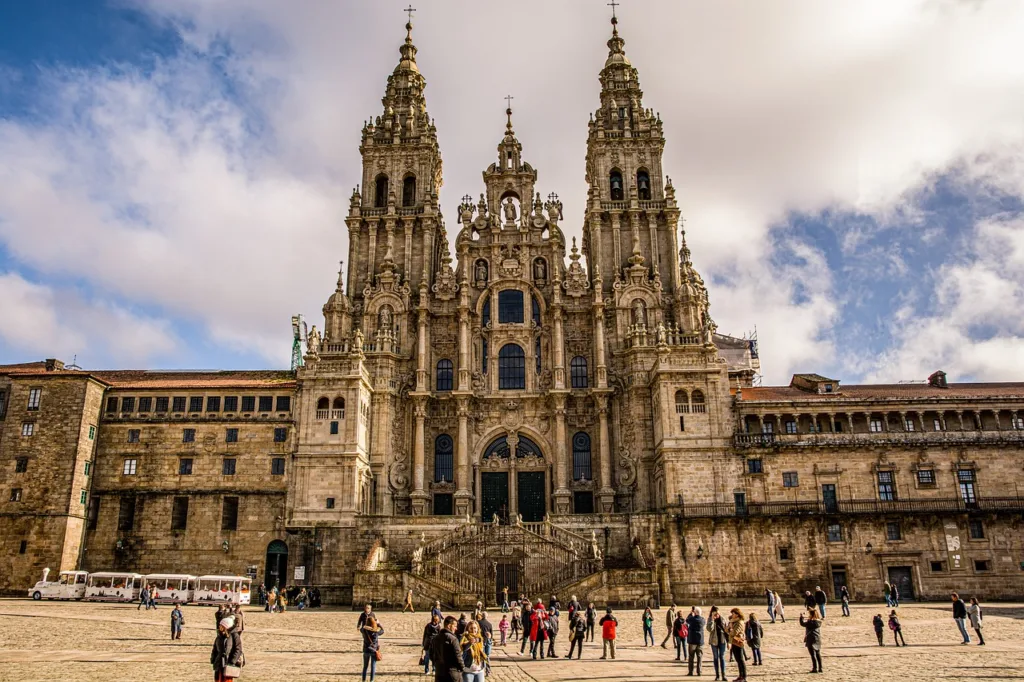
Since the Middle Ages, travelers have made Santiago de Compostela, home of the beautiful cathedral of Santiago (St. James), their ultimate destination. The cathedral was constructed to store and honor the saint’s relics. (Today, the medieval town of Santiago de Compostela remains a popular tourist destination in the Galicia area of Northern Spain, drawing in pilgrims from all over the world).
Constructed between 1060 and 1211, the cathedral is a remarkable example of Early Romanesque architecture. Although the outside underwent a Baroque change in the 16th and 18th centuries, the interior remains true to the original Early Romanesque design.
As you reach the west front, you’ll witness the best examples of both these eras at work, with one of Spain’s most striking church façade. Step inside to see the Pórtico de la Gloria, a portion of the former west front that is currently hidden by the facade from the 18th century. One of the world’s biggest and most exquisite collections of Romanesque sculpture is this triple entryway.
Constructed above the Apostle’s grave, the intricately adorned Capilla Mayor serves as the main attraction of the interior. A wooden image of the Apostle from the thirteenth century, magnificently embellished with precious metals and stones, stands in the middle of the high altar made of jasper, alabaster, and silver.
Narrow steps on either side climb up behind the figure, allowing pilgrims to kiss the Apostle’s cloak, marking the end of their journey. The remains of the Apostle are in a silver casket in a vault beneath the altar.
Plaza Mayor, Madrid

Plaza Mayor, the beating heart of Madrid, has been a significant feature of daily life in Spain since Philip II, the builder of San Lorenzo de El Escorial, his favorite architect, was given the job of building it in the sixteenth century.
The Plaza Mayor, one of Madrid’s most popular tourist destinations today, has long been the site of ceremonial events like the coronation of saints, the burning of heretics, and the announcement of a new king, as well as open entertainment like bullfights and chivalric contests. .
Madrid’s living room, the cafés that overflow onto the pedestrian-only stone pavement of the plaza and the restaurants that are shaded by its arcades are well-liked gathering spots for both locals and visitors.
One of the greatest areas to stay in Madrid is the neighborhood surrounding the Plaza Mayor, which is the hub of the city’s social scene.
Plaza de España and Parque de María Luisa, Seville
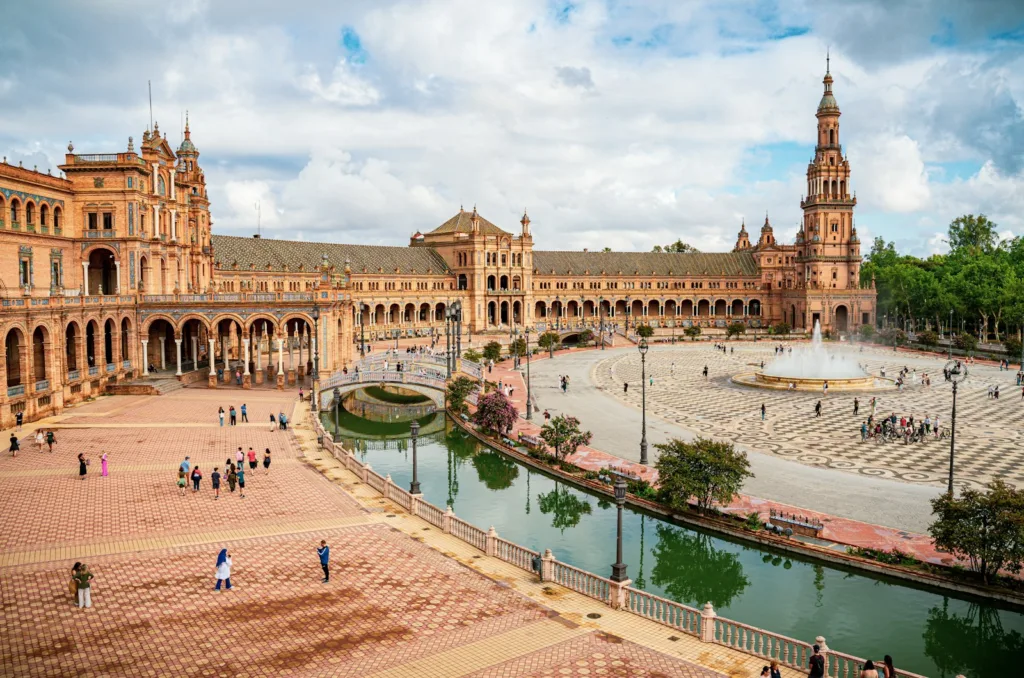
Constructed for the 1929 Ibero-American Exposition, the Plaza de España is a striking semi-circular pavilion encircled by colonnades, honoring the several regions of Spain. Overlooking the long pool, which is linked by bridges, are exquisite panels of multicolored mosaic tiles depicting each province in Spain. It’s a well-liked spot to stroll or row a rented boat around the swimming area and beneath the arches.
The large Parque de María Luisa, which is located across central Seville and consists of a half mile of gardens, lawns, and shaded paths along the river, centers around the Plaza de España. You can take a horse-drawn carriage trip or rent a pedal car. Every day is busy, but on Sundays the park is crowded with families.
Strolling through the park and taking the side routes into gardens covered by hedges is the finest way to take in the enormous trees, flower beds, lakes, gazebos, and the artificial rock mountain with a waterfall. A modest but rich archeology museum with antique gold work and jeweled Visigoth crosses can be found at the far end of the park.
Ciudad de las Artes y las Ciencias, Valencia

Valencia was left with a wide, level riverbed that was crossed by bridges when the river that had frequently inundated the city was rerouted. The talented Spanish architect Santiago Calatrava built a stunning collection of buildings that have drawn interest from connoisseurs of modern architecture using this simple color scheme.
In addition to the structures, Valencia is home to some of the most well-liked tourist destinations in Spain, including museums, performance spaces, and an aquarium (built by Félix Candela and the only structure not by Calatrava).
Constructed in the shape of a water lily, L’Oceanogràfic is the largest oceanographic aquarium in Europe, featuring structures devoted to various aquatic ecosystems ranging from the tropics to the poles.
Beaches of Gran Canaria
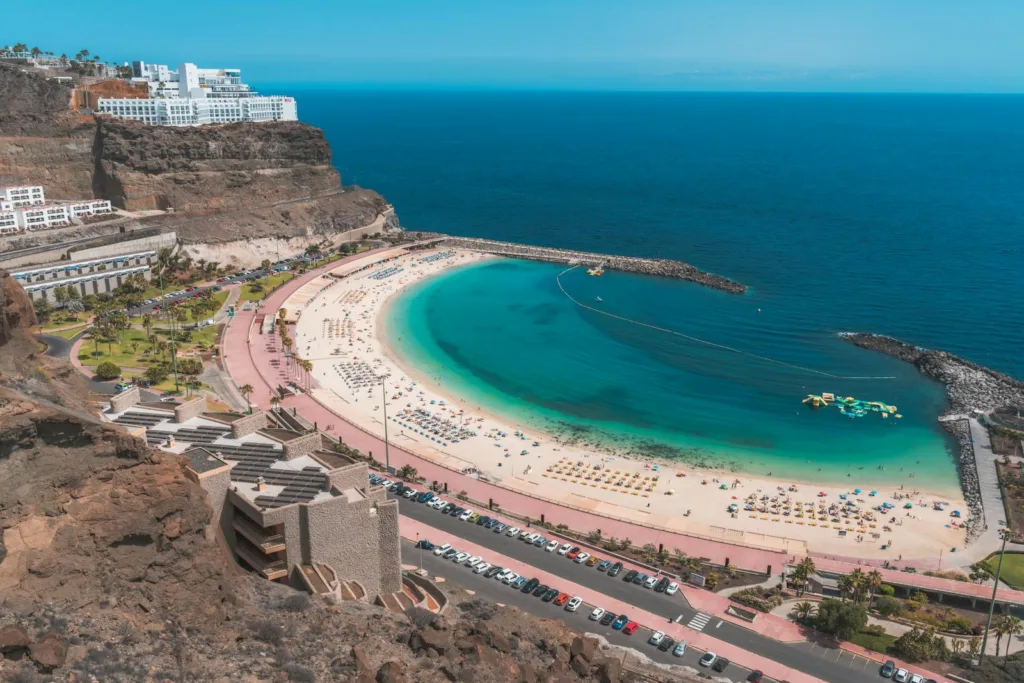
Gran Canaria, the largest of the Canary Islands, is primarily known for the golden-sand beaches that adorn much of its southern shore. Family-friendly Playa de Las Canteras, located in the capital city of Las Palmas, is well-liked for its tranquil waves, which are shielded by a natural barrier made of volcanic rock.
The Playa del Inglés in Maspalomas is the biggest and liveliest beach, with many restaurants, shops, cafés, play parks, and other entertainment options. One of the archipelago’s natural treasures, a sizable protected area of enormous sand dunes, is located at one end. These can grow up to 12 meters high and are always changing due to the sea and wind sculpting them. You can take a camel ride across this barren and otherworldly environment to complete the illusion of the desert.
Divers like this area because of the reasonably warm and crystal-clear water. A diving school is located at Playa del Inglés, and there is an underwater park at Arinaga, among other locations along the coast. Alternatively, you can take a glass-bottom boat trip to observe the fish and other marine life. Popular activities on the south shore include sailing and windsurfing.
La Rambla, Barcelona
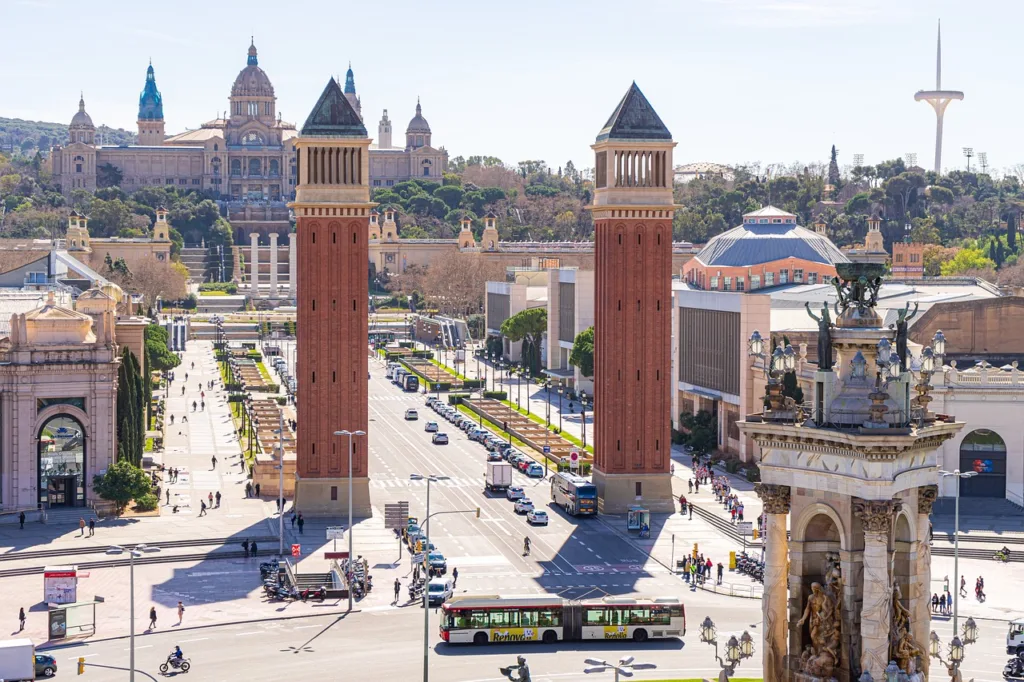
When you stroll along La Rambla in the summer, you may feel as though everyone who lives in Barcelona is right beside you. It’s unquestionably the place to be on a weekend or on a warm evening after work. This tree-lined avenue, which stretches northwest from the Columbus Memorial at the harbor, makes a green, if not particularly straight, cut across the city center.
Plane trees adorn the area leading up to the Plaça de Catalunya, which has a broad pedestrian zone with a narrow road on either side. La Rambla contains flower and bird markets, numerous book and newspaper stands, and cafes and restaurants with outdoor seating. Its vibrant environment is enhanced by street musicians, impromptu performers, living statues, and pavement artists.
The Mercat de la Boqueria (91 Rambla), a historic covered marketplace offering fresh vegetables, meat, fish, bread, cheese, and other specialty delicacies, is one of La Rambla’s highlights. Residents shop here for ingredients to make meals at home. The opportunity to taste local specialties offered at the market’s tapas bars will be appreciated by visitors.
The Costa del Sol

The Costa del Sol, a seemingly endless stretch of beaches and cities along Spain’s southwest Mediterranean coastline, has long been a popular vacation spot for sun-loving northern Europeans. This place has great summertime weather, with long, hot days and steamy, exciting evenings.
Along this region, the glamorous and flashy Marbella with its well-known harbor teeming with opulent boats and Malaga with its beautifully renovated center and the breathtaking Alcazaba located on the summit are must-see cities. If you’d rather something tastier, explore Neerja’s charming tiny village.
Aside from the exciting cities, the main attraction here is the beaches. It’s almost hard to resist going swimming when you see the turquoise waters crashing over the smooth, golden sand. Actually, a large number of Spain’s top beaches, each with its own distinct personality, can be found along the Costa del Sol.
El Teide, Tenerife
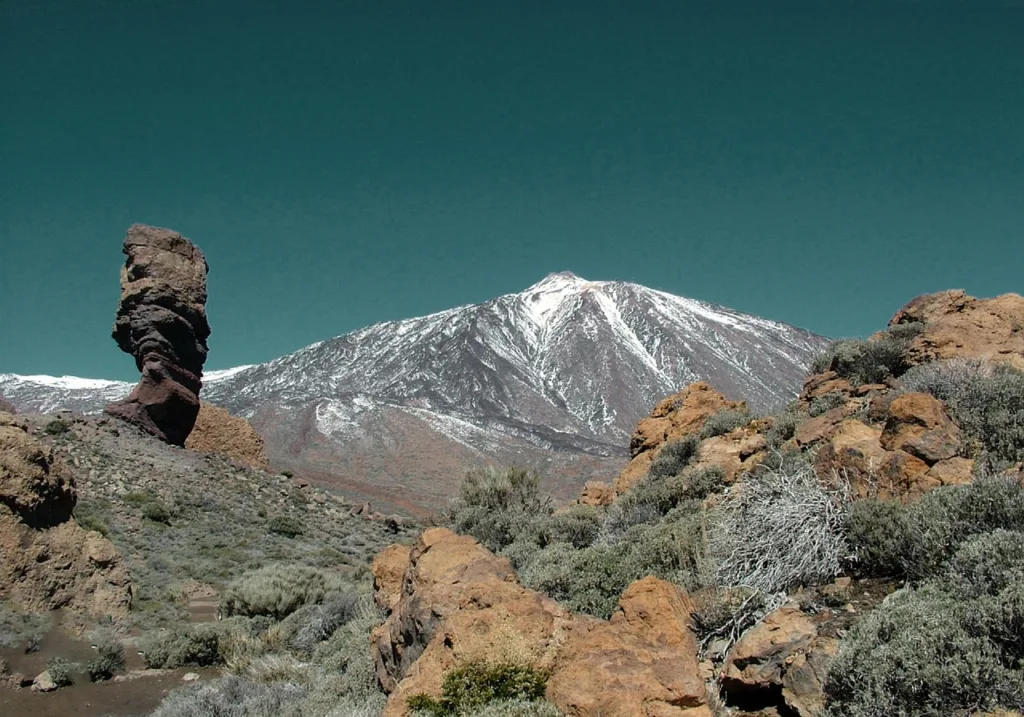
Tenerife, one of the Canary Islands’ top attractions, is quite the place to be. But the island’s true uniqueness lies in El Teide.
This ancient volcano, which is still smoldering, is the highest peak in Spain and one of the greatest natural wonders of Europe. The Parque Nacional del Teide is located in the middle of the island of Tenerife and is made up of the Pico del Teide and the Caldera de las Cañadas, a massive volcanic crater. Due to its outstanding natural beauty, the park was listed by UNESCO in 2007 along with “its importance in providing evidence of the geological processes that underpin the evolution of oceanic islands.”
El Teide can be explored in a number of ways. The crater floor, or caldera interior, is 12 miles in diameter and features a desolate moonscape of multicolored rock formations that resemble driving into the center of the earth. You can drive or stroll over it. Although you can climb El Teide’s cone, taking an eight-minute cable car ride will get you far closer to the summit. When the weather is clear, one can see the entire archipelago and even North Africa, which is the closest land mass to the Canary Islands.
Toledo’s Old City
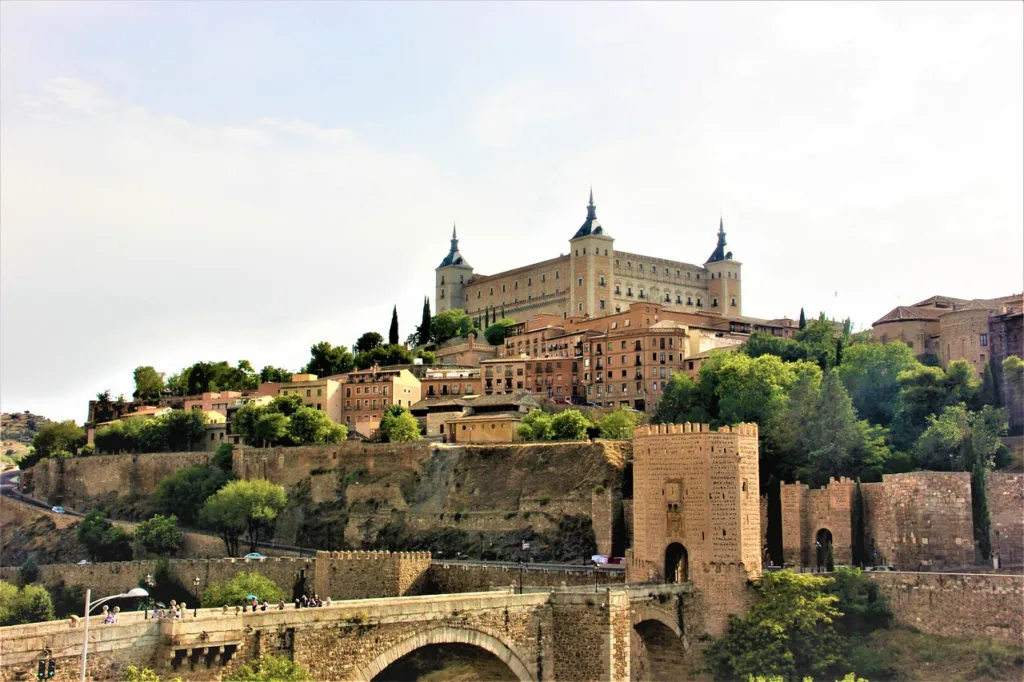
It’s great to just stroll around Toledo and get lost in its winding lanes. The town’s uneven street plan and abundance of blind alleys are remnants of its Moorish heritage, while the numerous churches, convents, and hospices serve as examples of Christian architecture. Because of this, the Casco Histórico (Old Town) is akin to an outdoor museum that depicts Spanish history and has been recognized by UNESCO as a component of mankind’s cultural heritage.
El Greco depicted a metropolis where Moorish, Gothic, and Renaissance architectural styles coexist in one of his most well-known paintings. The mediaeval city of Toledo, perched atop a granite hill and encircled by the deep gorge of the Tagus River on three sides, has a breathtaking profile when viewed from below.
The two synagogues in the charming ancient Judería (Jewish neighborhood) are elaborate in the Moorish style, and the magnificent Gothic Catedral de Toledo is one of Toledo’s main tourist attractions with its beautifully painted interior. See the church of Santo Tomé, an El Greco masterpiece, while you’re in the Judería.
Just an hour’s train ride from Madrid makes Toledo a convenient destination for a day trip, but it’s also a great place to stay the night, allowing you to explore the city later in the day and take in the ambiance at night.
The White Towns of Andalucía
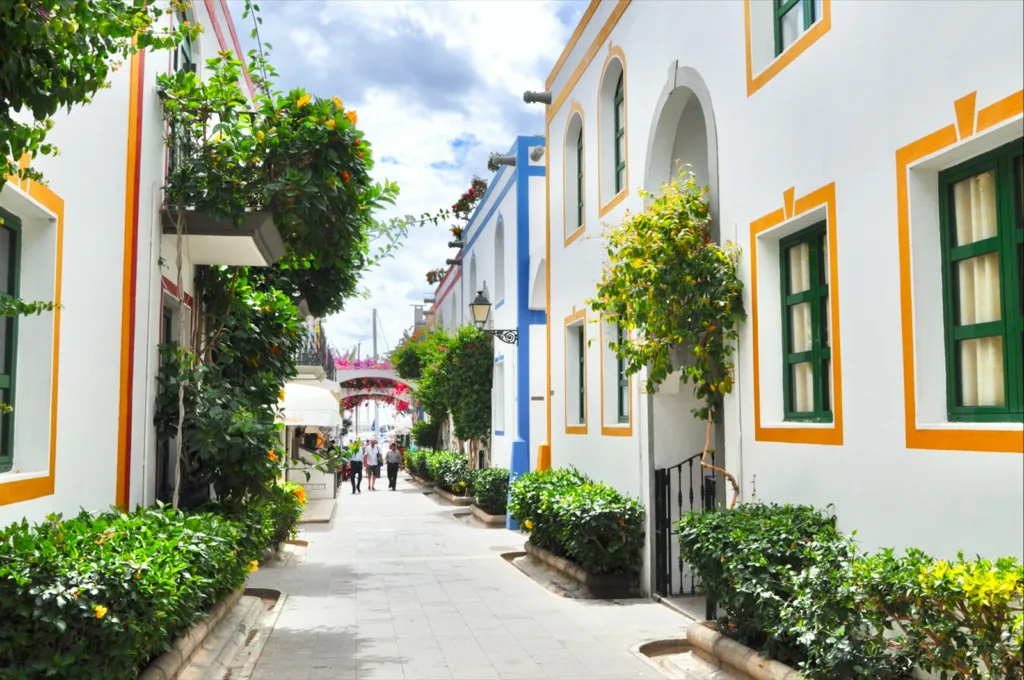
The White Towns, also known as Pueblos Blancos, are stunningly situated atop the rocky crags of southern Andalucía, resembling dabs of white frosting. Their significance stems from the region’s rich and varied history. These hilltop whitewashed settlements are hidden among the mountains that climb straight from the sea to the west of Gibraltar.
The most striking is Arcos de la Frontera, a plaza next to a Gothic cathedral that terminates abruptly in a 137-meter cliff, offering views over an almond, orange, and olive valley. Its meandering alleyways made of cobblestones lead to a Moorish castle, passing cafes and artisan stores offering pottery and ceramics.
These little white-house communities, numbering 19, are located in the vicinity of the Grazalema Nature Reserve. Two more that are well worth visiting are Grazalema and Zahara de la Sierra. Jerez de la Frontera, the birthplace of Andalucian thoroughbreds and flamenco, makes an excellent base in the area. Visit the Royal Andalucian School of Equestrian Art to witness the precise ballet of these horses, and go to Centro Cultural Flamenco to experience real flamenco.
Setenil de las Bodegas, where many of the buildings are carved into or beneath the rock walls, is one of the most photographed towns.
Ibiza

Ibiza is renowned across the world as a destination for sun-loving fun. Thanks to its great beaches and vibrant towns, the island has always been popular with young people. Ibiza’s beaches are crowded with people during the day as they enjoy the surf and sun, while at night, specific sections serve as popular gathering places where DJs play the newest music.
But many people are unaware of the fact that Ibiza is also a fantastic location for learning about the past. Stroll through the cobblestone lanes of Dalt Vila, the historic neighborhood recognized by UNESCO, and you’ll come across a startling amount of well-preserved Gothic Catalan buildings. The fortress, perched above it all, provides breathtaking vistas.
The peaceful coves of Portinatx are a great place to go if you’re looking for some adventure away from the masses. Enjoy the solitude and peace of the soft beach by spreading your towel out.
Ronda
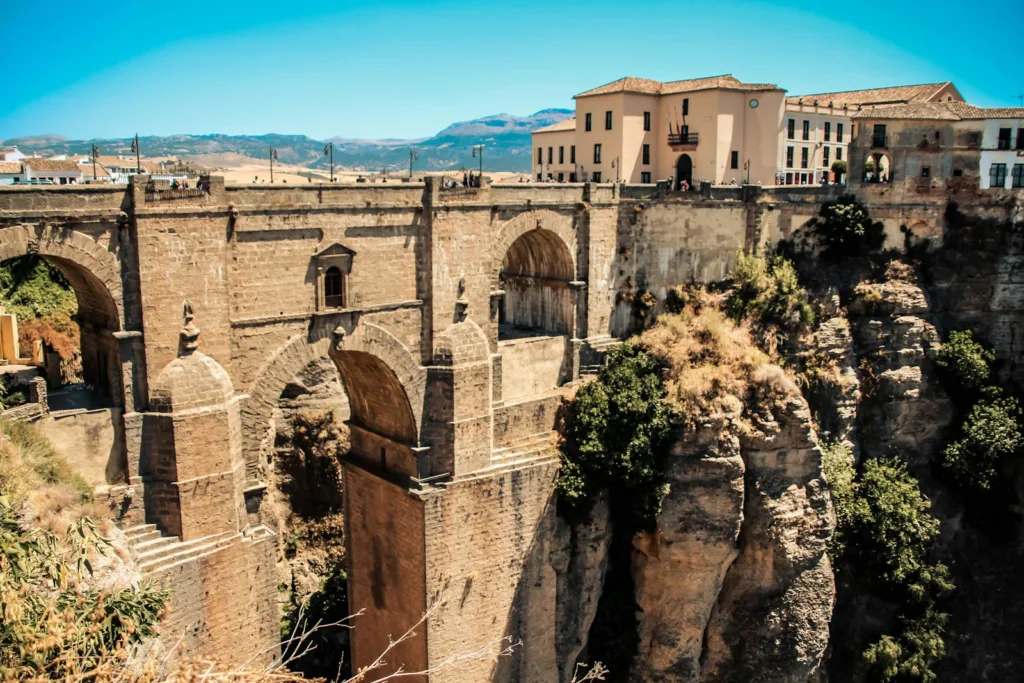
One of the highlights of a trip to Spain’s Andalucia region is the medieval city of Ronda. This city absolutely screams to be shot, perched as it does on a rocky outcrop with a medieval bridge and a well-preserved ancient town.
Ronda is incredibly easy to navigate on foot. The Puente Nuevo bridge, which spans the 100-meter-deep Tajo de Ronda valley, the Plazas de Toros bullring, and La Cuidad, the historic Moorish town center, are just a short stroll from one another.
After a day of exploring the sites, get a great patio seat at the Plaza del Socorro. Some passages in Ernst Hemingway’s book For Whom the Bell Tolls may be familiar to readers.
read also : Switzerland Best 15 Attractions & Destinations
Spain Spain Spain Spain Spain Spain Spain Spain Spain Spain Spain Spain Spain Spain Spain Spain Spain Spain Spain Spain Spain Spain Spain Spain Spain Spain

